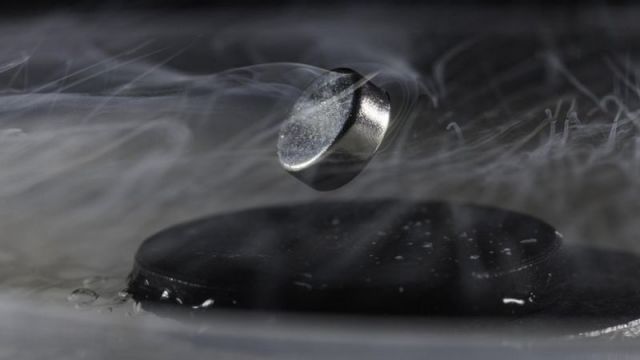
Hi folks!
This guy is two weeks late, I was struck down by Tonsillitis for a week and spent the rest of my time catching up on my research - which is a shame. This newsletter is fortnightly in spirit, but in reality it’s evidently not. Oh well, let’s say that a newsletter once every two weeks is an aspirational target.
I’m really happy with this week’s write-up, we cover some heavy stuff in the album recommendation but that’s balanced by the singles that are wall-to-wall groovy noise. In the science section I give a rundown of superconductivity, alongside a new discovery that’s quite an important development for specialist technologies.

A magnet levitating above a supercooled superconductor thanks to the Meissner Effect. Credits: University of Rochester/J.A. Fenster.
As you read this, electricity is being channelled from its source and into your screen. This source is likely to be a turbine which is spinning in the heart of a generator somewhere, converting the mechanical energy of its rotation into electrical energy. Imagine it happening now. Imagine a hydropower plant like this one. Water is driving a turbine which spins a device called a rotor. This rotor is a disc with magnets fitted on its circumference. As the rotor spins so do the invisible magnetic fields generated by these magnets. The rotor sits inside a stationary shell, called a stator. As the magnetic fields move, they jostle and move the electrons sitting inside the conductive metal fitted within the stator, we’ll call them conductors. The more the rotor moves, the more the electrons are moved. This movement is called a current. The electrons in the conductor generate an invisible electric field that now surrounds the wire. As these fields begin to move, perhaps travelling down a wire, they become the physical phenomenon known as electricity.
Electricity travels from the stator, through the power station, along hundreds of miles of cables and wires, and enters your computer. Once it has done its job, allowing you to stare at these words, electrons leave your computer and return to a power substation (this is why there are multiple wires inside a power cable). Electricity must always return to its source, this circular flow is responsible for the term circuit in electronics. If the circuit is broken, electric charge builds up until it finds somewhere else to go - and that’s how you get electrocuted.
The ability of electrons to flow through a material is dependent on its conductivity, which describes how well it conducts. Current can be thought of as a stream that flows best when it is unobstructed. In this way, it’s intuitive that a material is most conductive when is has an ordered structure, few impurities, and when the electrons within are weakly bound to the atomic nuclei of whatever chemical substance the material is made from. The opposite to conductivity, resistivity, quantifies the amount a current is inhibited by a material. This inefficiency manifests itself as heat, which will emanate from the conducting material. We have now laid the groundwork to understand superconductors.
Heat makes things move. It’s why the water in your kettle boils. When a conductor is heated, the atoms it is made from will move, which impedes any current that is flowing through the material. If a conductor is cooled down then we observe resistivity decreasing. As the temperature draws near to its lowest possible value, absolute zero, the resistivity becomes zero. The point at which this happens is known as the critical temperature. However, this isn’t the only thing we observe. Now that there is no heat loss, a current can flow through the conductor indefinitely. Strange things begin to happen: our conductor has entered a new state, it has become a superconductor.
Remember when the magnetic field of the generator’s rotor created a current in the conductors? This is known as induction. Likewise, the induced current will also produce a magnetic field which is opposite to the original. With a superconductor the induced magnetic field is equal to the field being applied such that they are cancelled out. The manner in which this happens is complicated and leads to a complete expulsion of magnetic fields from the interior of the superconductor. This is not simply a result of perfect conductivity, it’s the uniquely weird behaviour of the superconducting state. This is the Meissner effect, and is shown by the image above. The Meissner effect means that if I place a magnet on top of a conductor, which I then supercool, the magnet will begin to levitate. This levitation will continue for as long as the conductor is in a superconducting state.
Superconductors open a door into the development of technologies with frictionless components: Maglev trains utilise the levitation generated by the Meissner effect to create trains that float above their tracks. Another physical phenomenon of superconductivity provides additional control: Flux pinning allows for components to be fixed in space - this ensures that the maglev train cannot deviate from the path set for it. Maglev trains are more efficient, can travel faster, and are easier to maintain than traditional trains. They are undoubtedly the future of public transport. Where else can we use superconductors? The high conductivity allows for a high current and therefore incredibly strong magnetic fields to be generated. This is why superconductors are used in MRI machines, the strong magnetic fields can align the Hydrogen atoms and supercooled devices called Josephson Junctions can detect the delicate changes in the atoms.
The main issue with superconductors is how cold they need to be. It’s difficult and costly to maintain materials in a superconductive state. For instance, the superconducting components of an MRI machine are fed supercool liquid helium, which is expensive and requires heaps of insulation. For this reason, materials that can achieve superconductivity at “normal temperatures”, what physicists often call room temperature, are sought after. And, at long last, this brings me to the paper at the heart of this article: Room-temperature superconductivity in a carbonaceous sulfur hydride by Elliot Snider, Nathan Dasenbrock-Gammon, Raymond McBride, et al. Let’s quickly breakdown the results of the paper and its implications.
Firstly, what is Carbonaceous Sulfur Hydride? The sample used in the experiment was created by pressurizing a mixture of Methane and Hydrogen with Hydrogen Sulfide. Hydrogen Sulfide is often produced by microbes during the decomposition of organic matter and its (partly) responsible for the gross smell produced by rotten eggs. The pressure required to synthesize the Sulfur Hydride is three quarters of that experienced at the centre of the Earth. This material achieved superconductivity at an astonishing 15 degrees Celsius. That’s the equivalent to the superconductor functioning on a very pleasant autumn day.
What are the implications of a room-temperature superconductor? The power infrastructure I discussed earlier could become super efficient - no losses through heat. Frictionless components, such as those used in Maglev trains, become a far less exotic technology, and who knows where the supreme control over magnetic fields could lead. And finally, sensing equipment - be it medical or otherwise - would become far less expensive and cumbersome. So can we expect to see levitating cars hovering above Sulfur roads in the immediate future? Sadly not. If Sulfur Hydride is left outside its pressurized conditions for too long then the material will decay. This is a clear limitation of Carbonaceous Sulfur Hydride and something that shall have to be overcome if its ever to be used. BUT, it is progress. Perhaps it won’t be Sulfur, but we have made huge leaps towards synthesizing a practical superconductor that functions in normal conditions and, hopefully, is inexpensive.
Now we’ve established the basics, I might build on this contemporary superconductivity in an article later on if folks are interested.

A still from the video of Black Rain, Copyright Loma Vista Recordings.
Peddlers of dreamy sex-groove, Rhye, have released their song Black Rain in preparation for the release of their new album Home. It’s a composition of all the best parts of their back catalogue: Mike Milosh’s trademark falsetto vocals, deep synth, and elegant strings. The song wonderfully changes tempo, switching between texture and speed whilst remaining groovy. It’s an incredibly strong entrance for the new album. The synths lend a gnarlier tone to some of their previous releases, but the sound keeps its composure. I’m excited to hear what the band have in store next. PS - after hearing the song, you’ll be unsurprised to hear that the music video is an extended shot of a well-built topless guy with a moustache dancing. It fits the vibe.
The next single is another streamlined electric beast from Bristol’s Elder Island: Feral. It’s a tight release, the first of its kind since The Omnitone Collection came out last year. Omnitone was the group’s first album (so go have a listen to it if you liked Feral) and this song is a taster of their second which will be coming out next year. Elder Island rarely put a foot wrong, the songs have all the right pieces in all the right places and Feral is no exception. The beat is dark and persistent, very reminiscent of what Daft Punk put together for a bad film about tiny people inside a computer. There’s not too much to say about the song, it’s been made for you to dance to and it does the job well.
L’Impératrice are masters of modern disco. The Parisian group were instrumental in pulling me out of the early-lockdown malaise with their feel-good content: They released several videos, as many bands did, of themselves playing their music at home. L’Impératrice’s particular charm was how much fun they had, being silly and dancing around, whilst sounding fantastic. This is a good point to praise Flore Benguigui’s vocals which elevate the group’s music to another level. Anyway, they released Voodoo? earlier this year (the question mark is intentional, I promise). It’s a fun number that I enjoyed, but didn’t listen to much soon after its release. The Lazywax remix opens the song up, adds one or two new elements, and rewires things to make it irresistibly funky. If anyone claims disco is dead, you can shove this in their face to prove them wrong.
CW: Mention of the physical and sexual violence committed during the 1994 Rwandan Genocide.

Photo of The Good Ones by Marilena Umuhoza Delli, Courtesy of Anti- Records.
The core members of The Good Ones are Adrien Kazigira, Javan Mahoro, and Janvier Havugimana. Each are a member of the nation’s divided social groups - Hutu, Tutsi, and Abatwa. The origins of the former two, Hutu and Tutsi, are incredibly controversial and ultimately a tool used to peddle conflict. Whatever the beginnings of these designations, one thing is certain: during Belgium’s colonisation of central Africa in the first half of the 20th century these divisions were intentionally exacerbated by the colonisers. Racist and baseless theories involving phrenology, faith, and cattle ownership were used to push people into a rigid social hierarchy that facilitated the continuation of Belgium’s control over their colony. Rwanda gained independence from Belgium in 1962, becoming another European nation that would flee the African continent leaving the hollow demons that they had embedded into the society’s culture.
In 1994, the president of Rwanda, Juvénal Habyarimana, alongside the president of neighbouring Burundi, was assassinated. Government forces reacted by indiscriminately and systematically killing anyone labelled as a Tutsi. All facilitated by the identification cards introduced by the Belgian colonal regime. Over a million people are estimated to have died amidst this genocide, and quarter of a million women were raped. Justice for the crimes committed was sought through the International Criminal Tribunal for Rwanda (ICTR), 93 individuals were indicted including the Prime Minister at the time, Jean Kambanda. The ICTR closed on December 31st 2015.
This is why the composition of The Good Ones is important. These musicians have come together across social divisions to heal the damage done to their people. Their name is a monument to this: It was an active attempt to seek out “the good ones" after having endured and witnessed unthinkable horrors. Their 2019 album, RWANDA, you should be loved, arcs through sombre tragedy and deep expressions of love, and throughout it all is sincerity. There is little artifice here. The band members are workers in the local agricultural district, much of the percussion in the album was created by the tools that were to hand on Kazigira’s farm - where the album itself was recorded and where Kazigira hid during the genocide. It’s difficult to communicate the circumstances of this album without coming across like a well-meaning but ultimately unhelpful celebrity in a festive charity ad: A white man in a branded white t-shirt gesturing at “Africa” and lamenting its “tragedy”. We should let the music speak for itself and for The Good Ones, so let’s do that.
The songs in RWANDA, you should be loved are sung in one of Rwanda’s native tongues, Kinyarwanda. Only the song titles have been translated to English, an artefact of this is that they read like prose. Within the tracks, The Good Ones pursue a kind of African bluegrass that’s imbued with the Kinyarwanda language. A few musicians who you may be familiar with feature on this album: Tunde Adebimpe, Nels Cline, Corin Tucker, and Kevin Shields. Their presence is subtle, and rightly so. These featured artists can only be detected by an extra instrument chasing the melody or an unfamiliar adjustment in composition. For instance, Kevin Shields features on A Long, Sad Journey Watching You Die. Despite the devastating title, the song gently ebbs and flows in an uplifting way thanks to Shields, who plays the swelling keys that lift Kazigira’s vocals.
My first pick from the album is Despite It All I Still Love You, Dear Friend, a deeply beautiful song. A video was released by ANTI-Records giving context for the track, which stumbles into life with acoustic guitarwork accompanied by what must be Adebimpe’s pitch-perfect whistling. It immediately breathes life into the air. Havugimana begins to play the tambourine, which remains with us through this touching song. Trust me; you’ll be charmed within seconds. The next pick is Where Did You Go Wrong, My Love, featuring Nels Cline, who is well known for his work in Wilco. Cline can be heard playing the electric guitar on the track. He adds to the song without tearing the delicate and vibrant fabric woven by The Good Ones as they endeavour to express their Rwanda through this album.
On a final note about this album: in a previous decade this album may have been labelled “World Music”. I cannot think of anything more insulting, stupid, and arrogant than calling this album such. It’s also an echo of those colonial roots - music within the Global North is perceived as a mosaic of different noises and sound, everything else is just… The World. The entire concept of RWANDA, you should be loved is evidence of how harmful and foolish this is. It’s an expression of an intimate relationship between people from a different culture with a nation we perceive from the outside. This is what music is about, showing us the interior and revealing the vibrancy that lies within. This album is a monument to that, and the world is brighter for it. I hate to end on cheese but: Rwanda should be loved, and it clearly is.
See you in two weeks and don't forget to support artists by buying their merch or music through Bandcamp!
Solidarity and love,
Nick
x
